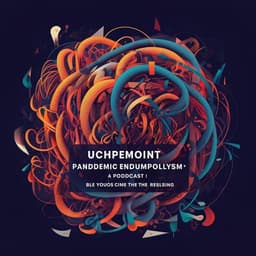
Economics
Sentiment and emotion in financial journalism: a corpus-based, cross-linguistic analysis of the effects of COVID
C. Vargas-sierra and M. Á. Orts
This study explores the dramatic shift in language within financial newspapers during the COVID-19 crisis, examining both English and Spanish publications from 2018-2021. Conducted by Chelo Vargas-Sierra and M. Ángeles Orts, the research unveils how sentiment and emotion transformed amidst economic upheaval.
~3 min • Beginner • English
Introduction
The study examines how the COVID-19 crisis reshaped sentiment and emotion in financial journalism. Against the backdrop of lingering effects from the 2008 financial crisis, and new pressures from climate change and the pandemic, the authors compile comparable English and Spanish corpora (The Economist and Expansión) for 2018–2019 (pre-COVID) and 2020–2021 (COVID). Research objectives are to illustrate and measure business sentiment and emotions via linguistic data and to relate these to market-relevant affect (fear vs. greed). Hypotheses: (H1) sentiment polarity/intensity will shift to a more negative tone during COVID compared to pre-COVID, similarly across English and Spanish; (H2) topics will change with newspaper scope, centering on financial issues pre-COVID and on the health crisis during COVID. A premise anticipates notable cross-period and cross-outlet variation in the eight Plutchik emotions, mapping onto risk aversion (FEAR) and risk attraction (GREED).
Literature Review
The theoretical framework situates the analysis within two periods: pre-COVID (2018–2019), still shadowed by the 2008 crisis and characterized by slow recovery, low interest rates, trade tensions, and climate concerns; and the COVID period, marked by lockdowns, supply bottlenecks, inflationary pressures, and climate transition costs. In linguistics and social sciences, sentiment is the positive/negative subjectivity in texts, while emotions (e.g., fear, joy, anger) capture specific affective states. Prior work connects emotions to economic behavior and financial markets, challenging rational choice assumptions; fear and greed are widely acknowledged drivers of market volatility. The CNN Fear & Greed Index and VIX signal market sentiment. Plutchik’s model (joy–sadness, anger–fear, trust–disgust, anticipation–surprise) underpins emotion taxonomy. The authors adapt this framework to markets by conceptualizing GREED as a secondary emotion combining ANGER (drive to overcome obstacles) and JOY (reward/progress), opposed to FEAR (risk aversion) and SADNESS. TRUST/DISGUST and ANTICIPATION/SURPRISE are treated as moderate/mild emotions along the risk aversion–attraction continuum. This framework motivates linking emotion lexicons to market-relevant behaviors.
Methodology
Design: Corpus-based, cross-linguistic study with automated sentiment and emotion analytics. Corpora: English corpus (The Economist) 3,736,103 words across 3,735 articles; Spanish corpus (Expansión) 1,965,154 words across 1,589 articles. Periods: pre-COVID (2018–2019) and COVID (2020–2021). Sources/queries: Texts retrieved via ProQuest Central (The Economist) and Dow Jones Factiva (Expansión) using matched queries. For 2018–2019: “climate change” AND “economic crisis” OR “havoc” OR “interest rates”. For 2020–2021: “covid” AND “climate change” AND “economic crisis” OR “havoc” OR “interest rates” OR “pandemic”. Sub-corpora were built for each outlet and period.
Tools and processing workflow: Text compilation/cleaning → corpus and sub-corpus building → processing with (a) Lingmotif 2 (for polarity and intensity), (b) Sketch Engine (frequency lists), (c) NRC Word-Emotion Association Lexicon (EmoLex) for eight-emotion tagging. Due to Lingmotif 2 limits, approximately 1 million-word samples per sub-corpus were used for TSS (polarity) and TSI (intensity). EmoLex (∼14,000 English unigrams with Spanish equivalents) provided binary emotion and polarity tags aligned to Plutchik emotions; word–emotion matching was automated (e.g., Excel XLOOKUP). Emotion frequencies were computed as relative frequencies (hits per million) and aggregated to percentages. Topic analysis used Sketch Engine’s document co-occurrence frequency (DOCF) to identify dominant nouns/topics (thresholds: >20% DOCF pre-COVID; >25% during COVID).
Fear–Greed mapping: GREED operationalized as ANGER+JOY lexical items; FEAR as EmoLex FEAR category. Nouns were emphasized due to nominalization in specialized discourse and topic salience.
Statistical testing: A paired-sample t-test (SPSS) assessed changes in negative polarity frequencies before vs. after the pandemic across adjectives, adverbs, nouns, and verbs in both languages (PRE-COVID vs. COVID). Reported outcomes include mean difference, SD, SE, correlation (r), p-values (one/two-sided), and 95% CI.
Key corpus statistics: The Economist words by year: 2018: 433,422; 2019: 452,255; 2020: 1,452,191; 2021: 1,398,235 (total 3,736,103). Expansión words by year: 2018: 221,378; 2019: 417,904; 2020: 550,064; 2021: 775,808 (total 1,965,154).
Key Findings
Sentiment polarity and intensity (Lingmotif 2 samples):
- Pre-COVID Expansión: 64% positive sentences (257) vs. 36% negative (145); overall fairly positive; TSI average ≈74 (very intense).
- Pre-COVID The Economist: 22% positive (42) vs. 78% negative (151); overall fairly negative; TSI ≈75 (very intense).
- COVID Expansión: slightly negative overall; positive vs. negative items roughly balanced (≈48% vs. 51%); TSS average 49; TSI ≈81 (very intense).
- COVID The Economist: negative overall; 306 negative vs. 102 positive items; TSS average 40; TSI ≈76 (very intense).
Positivity/negativity (EmoLex, whole corpora, percentages):
- Expansión: positive drops 69.98% → 61.34%; negative rises 30.02% → 38.66%.
- The Economist: positive slightly drops 57.42% → 55.59%; negative rises 42.58% → 44.41%.
Emotion profiles (EmoLex):
- TRUST is the most frequent emotion in both outlets but decreases during COVID (Expansión: 31.96% → 26.48%; The Economist: 26.07% → 23.18%).
- FEAR and SADNESS increase in both (Expansión FEAR: 14.80% → 17.11%; SADNESS: 7.77% → 12.01%. The Economist FEAR: 15.16% → 16.97%; SADNESS: 10.58% → 11.98%).
- ANTICIPATION increases in Expansión (16.68% → 18.64%) but slightly decreases in The Economist (16.54% → 16.21%); JOY decreases in both.
Fear–Greed extremes (noun-based):
- Pre-COVID: higher reticence (FEAR) in Expansión; in The Economist, GREED exceeded FEAR (≈53% vs. 47%).
- COVID: both outlets show increased FEAR; COVID-related nouns (e.g., pandemic, case, lockdown, death/disease) dominate FEAR; investment-approach nouns (e.g., share, money, demand, deal, cash; Spanish: demanda, ganador, reto, dinero) represent GREED but are relatively diminished.
Topic shifts:
- Expansión: pre-COVID topics include climate change, economy/business innovation; COVID period dominated by health crisis lexis (pandemia, contagio, fallecido), with relatively less basic economic content.
- The Economist: broad macro/microeconomic coverage in both periods; during COVID, pandemic lexis becomes most frequent but interest rates, inflation, and related economic themes persist.
Statistical test (paired t-test on negative polarity frequency across POS):
- Significant increase in negative polarity post-pandemic: one-sided p = 0.028 (two-sided p = 0.056), mean difference = −17,788.875 (post > pre), SD = 21,935.973, SE = 7,755.537, 95% CI [−36,127.807, 550.057], strong correlation r = 0.996.
Overall: Emotional intensity remained very high across periods; negativity increased during COVID, especially in Expansión; The Economist maintained a more consistently negative tone across both periods with a broader topical spread.
Discussion
Findings only partially support H1. Emotional intensity (TSI) was high and comparable across periods and outlets, not markedly higher during COVID, contrary to expectation. Polarity did become more negative during COVID in both corpora (statistically supported), but The Economist was already fairly negative pre-COVID and remained so with modest change; Expansión shifted more sharply from fairly positive pre-COVID to slightly negative during COVID, largely via a reduction in positive items.
H2 is supported. Expansión pivoted strongly to health-crisis coverage during COVID, whereas The Economist sustained wider macro/microeconomic coverage while foregrounding pandemic effects; interest-rate and inflation topics remained salient only in The Economist.
Emotionally, TRUST dominated pre-COVID but decreased during COVID, while FEAR and SADNESS rose in both outlets, indicating a shift toward risk aversion consistent with market conditions. GREED (operationalized as ANGER+JOY) declined during COVID, reflecting diminished risk appetite. The shared trends across languages suggest similar economic atmospherics, though editorial stance and scope affect tone and topic breadth. Given the prestige and reach of these outlets, such linguistic shifts plausibly influence investor sentiment and behavior.
Conclusion
The study connects sentiment/emotion in financial journalism to crisis contexts by comparing English (The Economist) and Spanish (Expansión) corpora before and during COVID. Pre-COVID, Expansión was fairly positive while The Economist was fairly negative; during COVID both turned more negative, with Expansión’s deterioration more pronounced. Emotion analysis shows TRUST as the leading emotion that declines in COVID, while FEAR and SADNESS increase, indicating greater risk aversion. Mapping emotions to a Fear–Greed framework (GREED ≈ ANGER+JOY) shows a shift from moderate risk-taking toward avoidance during COVID in both outlets. By integrating lexicon-based emotion detection with market-relevant constructs (CNN Fear & Greed), the study demonstrates a viable bridge between linguistic signals and financially meaningful sentiment, suggesting that economic discourse is intimately intertwined with emotions rather than purely rational. The approach offers a basis for further exploration of how media language shapes and reflects market sentiment across crises.
Limitations
- Corpus imbalance and scope: Only two newspapers (one per language) with different sizes (EN ≈3.7M words; ES ≈2.0M) and distinct editorial scopes; findings may not generalize across outlets or broader media ecosystems.
- Lexicon-based constraints: Polarity/emotion tagging relies on static dictionaries (Lingmotif 2, EmoLex) that can misclassify context-dependent usages (e.g., “positivo” in COVID contexts). EmoLex non-English versions were machine-translated (Google Translate), potentially introducing noise.
- Sampling limits: Lingmotif 2 required sub-sampling (≈1M words per sub-corpus) for polarity/intensity, which may not capture all nuances present in full corpora.
- Language and period coverage: Only English and Spanish, two periods (2018–2019 vs. 2020–2021). Broader temporal and multilingual coverage could refine insights.
- Conceptual mapping: GREED operationalized as ANGER+JOY is a theoretical adaptation not native to Plutchik, which may oversimplify complex investor emotions.
Related Publications
Explore these studies to deepen your understanding of the subject.







